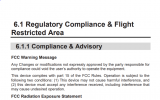herein2021
Well-Known Member
ok, here is the truth of the matter. DJI drones, since the P4, ALL BROADCAST THEIR ID. PERIOD. Can you turn this off? Yes. Well....YOU can't, but it can be done.
Can this be hacked and "spoofed"? Yes. It has been done and shown that it can be done. Do Autel drones broadcast their ID? Don't think so, but we have just started looking into the firmware and its capabilities. This could easily be turned on, if supported in their firmware, which I have no direct knowledge that it is. (haven't really looked yet to tell the truth)
As to herien2021's incident of his drones forced landing, I bet it was due to a TFR, which DJI's NFZ now picks up. Installing the FLY app, most likely updated the NFZ database on the phone or tablet. (shared database between DJI apps) You can NEVER, EVER update the app, or update firmware, and always firewall the app from internet access. DJI is very tricky when it comes to their apps...forced updates, data theft etc. (All proven) The DJI Apps will even launch, and connect to the internet in the background....yes, this is also proven fact. This is why you firewall their apps. Autel does not, from what we have seen so far.
Autels latest firmware makes you contact them and register the drone so it activates the warranty. You do NOT need to sign into the Explorer app, so they do not get your account info, UNLESS you want them to by signing into the app...unlike DJI which FORCES you to sign into the app, or you basically can't fly your drone. DJI drones MUST be activated with your account, in order to unlock them to fly. Are there ways around all of this "nanny state" stuff coming out of China on their drones? Yes.
Y E S ! You just need to go to the right place.
*Do I firewall the Autel Explorer app, the same as I firewall all DJI flying apps? No, I do not. This should tell you something.
I checked for TFRs before the flight too, I really think the GPS or something glitched and thought I was within one of DJI's red zones. I hadn't updated in years, but when I got the DJI Mini 2, I had to get the new app to fly it; this incident happened on the very next Mavic Pro flight.






